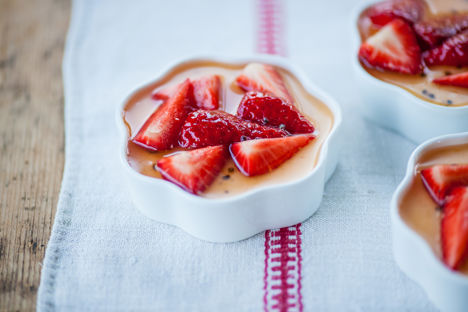Buttermilk is a natural dairy product, made from churning cream — something which has been done worldwide for countless centuries. Buttermilk appears in most cuisines from Russian oladi to Indian neer more, and buttermilk-fried chicken from the Deep South.
It's Irish dairy farms which are most closely associated with buttermilk though — using it in the national recipe for soda bread. The small, independent farms would save up their milk until they had enough to churn. So by the time that the fat had split into butter, leaving the buttermilk by-product behind, it would be sharp and tangy, with a cheese-like ripeness.
Shop-bought buttermilk varieties are softer tasting — creamier and more mild. They are made by adding a culture to milk, allowing it to ferment in a controlled environment. Though their tastes are very different, the properties of shop-bought and artisanal buttermilks are the same. Both contain enzymes which tenderise meat, making them great for marinades. And both are very acidic, meaning that a reaction takes place when mixed with an alkaline ingredient, creating carbon dioxide bubbles and causing breads and other baked goods to rise.
In the absence of buttermilk, lots of cook books advise adding lemon juice to milk to create a mock-version, which is acidic enough to make baked goods rise. Sales of buttermilk have seen a recent rise though, and the upshot is that it is become more and more widely available. Most decent-sized supermarkets stock a buttermilk in their dairy section — but try a good cheesemonger, or a local dairy like Ivy House Farm for a tangy, artisanal product.
How to cook with buttermilk
There are so many different applications for buttermilk — but in most culinary scenarios, it's best to treat buttermilk much like yoghurt. To make a sweet, pannacotta-like pudding, set buttermilk with gelatine, agar agar or iota carrageenan.
For a savoury sauce to dress anything from roasted vegetables to fish, loosen buttermilk with a little olive oil or a splash of water. It can even be dressed up into a ranch-style dressing by adding fresh herbs, garlic or salt.
Just as Middle Eastern recipes often tenderise lamb by massaging a yoghurt marinade over it, so buttermilk can be used the same way. As it's so liquid, the neatest way is to pour the buttermilk into a ziplock bag or vacuum bag, add the meat, and then leave it to marinate in the fridge for anything from 2 hours to 24 for chicken legs, and 48 hours for bigger cuts like a leg of lamb. A classic way of cooking small cuts of meat, like chicken wings, is to dredge the marinated meat in flour, so it sticks to the buttermilk, and then deep-fry it.
When using buttermilk for baking, the key is to mix it with an alkaline ingredient like bicarbonate of soda or baking powder. The acidity of the buttermilk means that a reaction takes place, which releases carbon dioxide bubbles and creates rise in anything from a loaf of bread to pancakes.
What buttermilk goes with
In the context of a sweet pudding, buttermilk makes a creamy, but quite neutral vehicle for more exotic flavours, like cardamom, rose water and bitter chocolate. The tanginess of a traditional, buttermilk soda bread helps slice through fatty flavours like foie gras and trotters, and is also delicious with a rustic jam or artisanal butter with a dash of fleur de sel.
Get in touch
Please sign in or register to send a comment to Great British Chefs.



